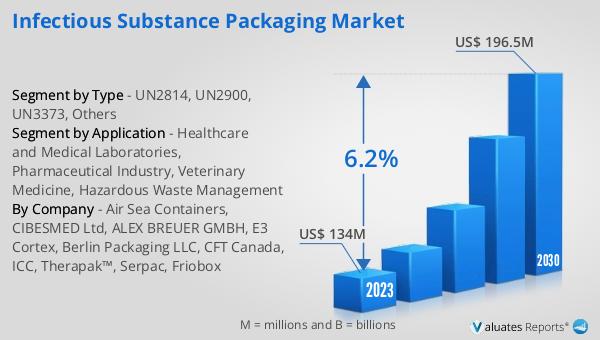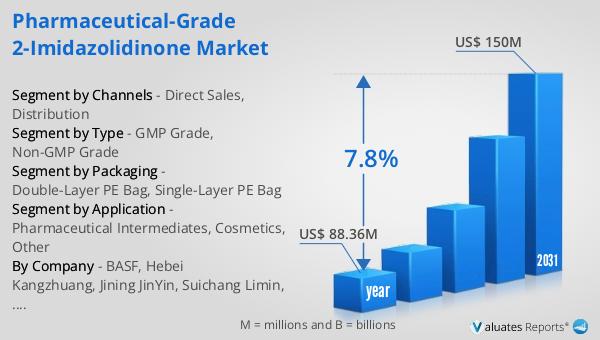What is Global Infectious Substance Packaging Market?
The Global Infectious Substance Packaging Market refers to the industry that specializes in the production and distribution of packaging solutions specifically designed for the safe transport of infectious substances. These substances can include bacteria, viruses, and other pathogens that pose a risk to human and animal health. The packaging must comply with stringent international regulations to ensure that these hazardous materials are contained securely during transit, thereby preventing any potential contamination or outbreak. The market encompasses a variety of packaging types, including primary, secondary, and tertiary containers, each serving a specific role in the containment process. The primary container holds the infectious substance, the secondary container provides an additional layer of protection, and the tertiary container ensures the overall integrity of the package during transportation. This market is crucial for sectors such as healthcare, pharmaceuticals, veterinary medicine, and hazardous waste management, where the safe handling and transport of infectious materials are paramount. The demand for these specialized packaging solutions is driven by the increasing prevalence of infectious diseases, stringent regulatory requirements, and the need for safe and efficient transport of biological samples for diagnostic and research purposes.

UN2814, UN2900, UN3373, Others in the Global Infectious Substance Packaging Market:
In the Global Infectious Substance Packaging Market, specific regulations govern the packaging and transport of infectious substances, categorized under UN2814, UN2900, UN3373, and others. UN2814 refers to infectious substances affecting humans, which are classified as Category A. These substances are capable of causing permanent disability, life-threatening, or fatal diseases in otherwise healthy humans. Packaging for UN2814 substances must meet rigorous standards, including triple-layer containment and absorbent materials to prevent leaks. UN2900 pertains to infectious substances affecting animals, also classified as Category A. These substances pose a significant risk to animal health and require similar stringent packaging standards as UN2814 to ensure safe transport. UN3373 covers biological substances, Category B, which are less hazardous than Category A substances but still require careful handling. These substances are typically used for diagnostic or investigational purposes and must be packaged in a way that prevents any leakage during transit. The "Others" category includes various infectious substances that do not fall under the specific UN codes but still require specialized packaging solutions to ensure safety. Each of these categories has its own set of guidelines and requirements, which are designed to minimize the risk of contamination and ensure the safe transport of infectious materials. The packaging solutions for these categories often include features such as leak-proof containers, absorbent materials, and secure closures to prevent any accidental release of the contents. The market for these packaging solutions is driven by the need to comply with international regulations, the increasing prevalence of infectious diseases, and the growing demand for safe and efficient transport of biological samples. Companies in this market must stay abreast of regulatory changes and continuously innovate to provide packaging solutions that meet the evolving needs of their customers.
Healthcare and Medical Laboratories, Pharmaceutical Industry, Veterinary Medicine, Hazardous Waste Management in the Global Infectious Substance Packaging Market:
The Global Infectious Substance Packaging Market plays a vital role in various sectors, including healthcare and medical laboratories, the pharmaceutical industry, veterinary medicine, and hazardous waste management. In healthcare and medical laboratories, these packaging solutions are essential for the safe transport of biological samples, such as blood, urine, and tissue, for diagnostic testing and research. Proper packaging ensures that these samples remain uncontaminated and that any potential pathogens are contained, thereby protecting healthcare workers and the public. In the pharmaceutical industry, infectious substance packaging is crucial for the transport of vaccines, biologics, and other therapeutic products that may contain live pathogens. These packaging solutions help maintain the integrity of the products and ensure that they reach their destination safely and without any risk of contamination. In veterinary medicine, the safe transport of infectious substances is equally important, as it involves the handling of samples from animals that may carry zoonotic diseases, which can be transmitted to humans. Proper packaging helps prevent the spread of these diseases and ensures the safety of veterinary professionals and the public. Hazardous waste management is another critical area where infectious substance packaging is used. This sector deals with the disposal of medical and biological waste that may contain infectious agents. Specialized packaging solutions are required to contain and transport this waste safely to prevent any environmental contamination or public health risks. The demand for these packaging solutions is driven by the need to comply with regulatory requirements, the increasing prevalence of infectious diseases, and the growing awareness of the importance of safe and efficient transport of infectious materials. Companies in this market must continuously innovate to provide packaging solutions that meet the evolving needs of their customers and ensure the safe handling and transport of infectious substances.
Global Infectious Substance Packaging Market Outlook:
The global Infectious Substance Packaging market was valued at US$ 134 million in 2023 and is anticipated to reach US$ 196.5 million by 2030, witnessing a CAGR of 6.2% during the forecast period 2024-2030. This growth is driven by several factors, including the increasing prevalence of infectious diseases, stringent regulatory requirements, and the growing demand for safe and efficient transport of biological samples. The market encompasses a variety of packaging solutions, including primary, secondary, and tertiary containers, each designed to provide a specific level of protection and containment. Companies operating in this market must stay abreast of regulatory changes and continuously innovate to provide packaging solutions that meet the evolving needs of their customers. The demand for these specialized packaging solutions is expected to continue to grow as the need for safe and efficient transport of infectious materials becomes increasingly important. The market outlook suggests that companies that can provide high-quality, compliant packaging solutions will be well-positioned to capitalize on the growing demand and achieve significant growth in the coming years.
| Report Metric | Details |
| Report Name | Infectious Substance Packaging Market |
| Accounted market size in 2023 | US$ 134 million |
| Forecasted market size in 2030 | US$ 196.5 million |
| CAGR | 6.2% |
| Base Year | 2023 |
| Forecasted years | 2024 - 2030 |
| Segment by Type |
|
| Segment by Application |
|
| Consumption by Region |
|
| By Company | Air Sea Containers, CIBESMED Ltd, ALEX BREUER GMBH, E3 Cortex, Berlin Packaging LLC, CFT Canada, ICC, Therapak™, Serpac, Friobox |
| Forecast units | USD million in value |
| Report coverage | Revenue and volume forecast, company share, competitive landscape, growth factors and trends |
